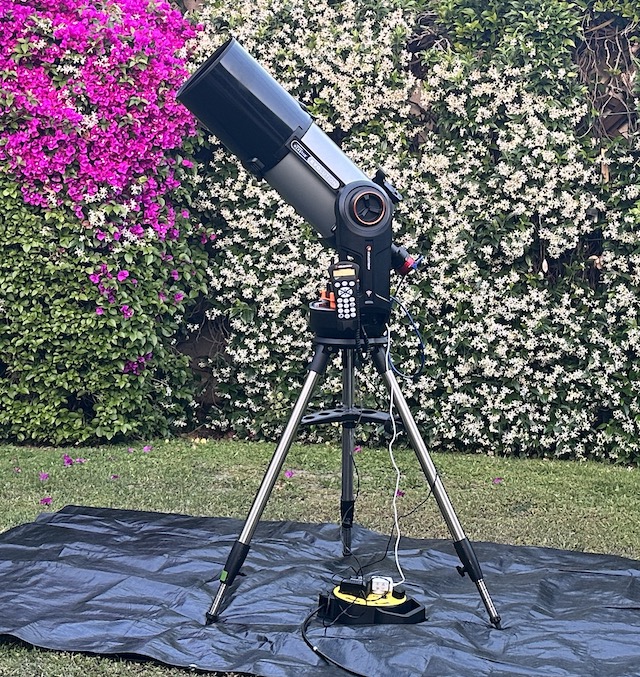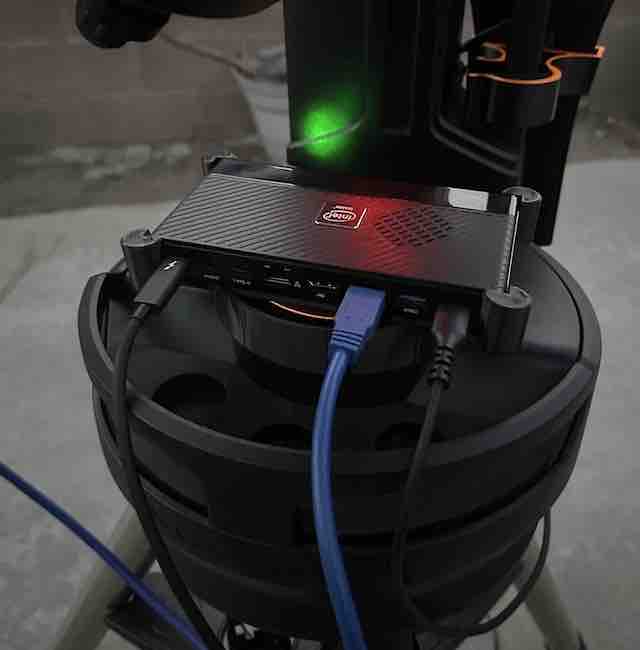For my EAA setup, I aimed for simplicity and flexibility, ensuring  I could quickly transition to visual observing without complications.
I could quickly transition to visual observing without complications.
While I've encountered complex arrangements online I've seen a lot of these configurations causing headaches, I chose to prioritize an enjoyable experience. My main EAA goal was enhancing my view of dim celestial objects, catering to my aging eyes. Although I still appreciate planetary observation, the camera's versatility greatly enhances my observations, especially during periods with fewer planets visible.
After extensive research, I settled on an 8" SCT telescope with a 2032mm focal length. This allowed for planetary and lunar viewing, with the option to use a focal reducer for deep-sky observations.
Additionally, I sought Go-To functionality due to worsening light pollution, which hindered object location through star hopping in my skies.
My setup comprises a Celestron Evolution 8" SCT, an uncooled ZWO ASI294MC camera, and a compact MoreFine mini PC. Remote access from my MacBook reduces cable clutter, while the mount connects via USB to prevent potential Wi-Fi issues. Although the mini PC connects wirelessly to my network, I've prepared a emergency backup Wi-Fi router for extended range. This setup eliminates problems faced with an older MeLE mini PC arrangement.
Setting up is a breeze. I keep the OTA attached to the mount and it's light enough to carry out onto the drive-way,  replace the diagonal with my image train, connect the hand controller and camera to the PC, align using CPWI, focus with the Bahtinov Mask, take my flats and I'm ready to go in about 15 minutes.
replace the diagonal with my image train, connect the hand controller and camera to the PC, align using CPWI, focus with the Bahtinov Mask, take my flats and I'm ready to go in about 15 minutes.
To avoid cable entanglement, I perch the PC on the mount's AZ knob with a holder I 3d printed, using short USB cables  for the hand controller and camera. The remaining cords for power are managed with cable extenders and I utilize the mount's cord wrap feature. Powering the mount with DC maximizes its performance, but the built-in battery proves convenient for impromptu observations or visual study.
for the hand controller and camera. The remaining cords for power are managed with cable extenders and I utilize the mount's cord wrap feature. Powering the mount with DC maximizes its performance, but the built-in battery proves convenient for impromptu observations or visual study.
For planetary imaging, I switch to a 2x PowerMate and the ASI294MC. When pursuing wider views or solar, I adapt the spacers for my William Optics Z61 scope.
I maintain reference photos of various configurations to streamline changes during nighttime observations, minimizing complexity and maximizing the enjoyment of exploring the cosmos.
Update
I recently added to my setup a Zenithstar Z61 refractor telescope from William Optics for wide-field astronomy. I pair it with an Astro-Tech 0.8X Reducer Field Flattener, which gives me an f/4.7 for even wider shots. I also added an ASI533 camera and switched from a MoreFine miniPC to an Intel NUC 11, upgrading it to 64GB of RAM for better performance with TheSky X and Sharpcap. I no longer recommend MoreFine miniPCs because they overheat and can't handle intensive software well, plus I had USB power issues. I no longer experience these issues with the Nuc.
To top off the setup I added a EQM-35 from SkyWatcher for rotation free sessions which I can use with the Z61 and the 8" SCT! I Still use the Celestron Alt-Az mount when doing visual planetary viewing. It's a much more convenient and faster setup and doesn't require polar alignment to get going.
Speaking of polar alignment, to make things easier on me and my knees, I picked up a Polemaster by QHYCCD. I am able to polar align and begin my session in less than 10 minutes with this handy device.
My Setup:
- Celestron Evolution 8" SCT
- Zenithstar Z61 Refractor Telescope
- ZWO ASI294MC
- ZWO ASI533MC
- Intel NUC 11 miniPC
- MacBook Pro to remote into PC
Software:
- CPWI to connect my mount to ASCOM
- EQMOD to control my EQM-35
- SharpCap to capture images
- TheSky to find objects and control the mount
Misc:
- Bahtinov Mask
- Tracing Light Panel for taking flats
- SkyTools4 for planning observations
Optional: